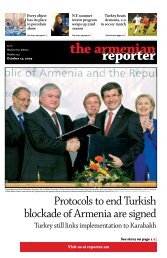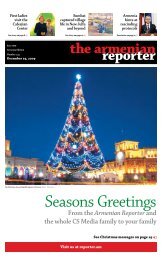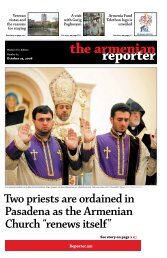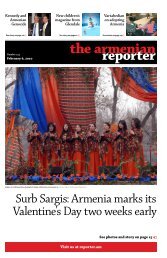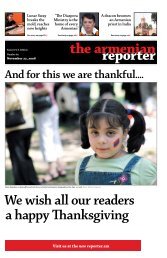You also want an ePaper? Increase the reach of your titles
YUMPU automatically turns print PDFs into web optimized ePapers that Google loves.
House on Wheelscritics’ forumAlina Mnatsakanian’s search for “home”by Ramela GrigorianAbbamontianLOS ANGELES - How do <strong>Armenian</strong>s,having crossed a number of borders andencountered many homes, construct adiasporic identity? Can the diasporic <strong>Armenian</strong>live in one place and still be partof another – a historic homeland, a siteof origin, a prior home? Post-colonialtheorists Bill Ashcroft, Gareth Griffiths,and Helen Tiffin, in defining “exile” withregard to diasporic peoples, wonder if“home” is in “the place of birth (nateo),in the displaced cultural community intowhich the person is born, or in the nation-statein which this diasporic communityis located” (Key Concepts in PostcolonialStudies. London and New York:Routledge, 1998, p. 93). These are questionsthat burden many <strong>Armenian</strong> artistsas well, including Alina Mnatsakanian.Mnatsakanian’s installations havebeen exhibited and her performancepieces have had a run in Los Angelesover the last several years. Her workcontinues to live online, asking questionswe have yet to answer. It engagesthe issues of “home” and “homeland” aswell as the incessant movement acrossborders and the encountering of manycultures. Mnatsakanian’s personal historyinspired many of her pieces: shewas born and raised in Iran (to Russian-<strong>Armenian</strong> and Iranian-<strong>Armenian</strong> parents)but left for Paris at the onset of theIranian Revolution in 1979. After pursuingan art education in Paris for severalyears, she settled in Los Angeles in 1983.After 22 years and several sporadic tripsto Armenia, she relocated once more, inSeptember 2005, to Switzerland.Mnatsakanian’s installation, Houseon Wheels (2000), confronts the issue ofconstant movement and hybrid identity.The installation incorporates a woodenstructure, audio recordings, and projectedimages on the wall, all of whichtogether create a multi-media and multisensoryspace of engagement. Hanginginside the house-shaped wooden frameare four large transparencies representinghomes and cultures the artist hasencountered: Iran, France, the UnitedStates, and Armenia. Each home is referencedwith very specific iconography,which includes such things as identificationcards, passport photos, metromaps, visas, and citizenship papers – allof them signifiers of movement, belonging/notbelonging, and the creation of“home.”Mnatsakanian considers her “homeland”Iran as well as Armenia, explaining,“It’s like a kid who has divorcedRamela Grigorian Abbamontian is an assistantprofessor of art history at Pierce College. She is alsoa Ph.D. candidate in art history at ucla. You canreach Abbamontian or any of the other contributorsto Critics’ Forum at comments@criticsforum.org. This and all other articles published in this seriesare available online at criticsforum.org. To signup for a weekly electronic version of new articles,go to criticsforum.org/join. Critics Forum is a groupcreated to discuss issues relating to <strong>Armenian</strong> artand culture in the diaspora.Alina Mnatsakanian’s personal history inspiredmany of her pieces.parents,” referring to the sense of attachmentone feels to more than oneplace (home) and implying an involuntaryseparation from an initial source oforigin. Even though Mnatsakanian citesher strongest connections to her birthplaceof Iran and to Armenia (noticeablythe most colorful transparencies), shehad created the home structure for Armeniawithout ever having visited thecountry – emphasizing my earlier suggestionthat “homeland” is an imaginedplace for many <strong>Armenian</strong>s. When theimagined place was transformed into areal one during her first visit, in 2001,ATWATER VILLAGE, Calif. - “DefiningPlace,” a group show exploring how artistsdefine their identity in terms of connectionto place, opens at the Center forExperimental Art and Architecture onFriday, December 5. The exhibit will beon display through December 15.“Defining Place” asks its audienceif home is simply a residence ofrefuge and safety or there are multipledefinitions of this term. Whatare the different kinds of connectionsto place, and how are definitionsof home and people’s connectionsto place shifting or changing?“Defining Place” brings togetherartists from across the UnitedStates who view their respectiveenvirons in unique ways.Ara Oshagan’s “Juvies” series exploresthe daily lives of a group ofincarcerated high-risk juvenile offendersin Southern California.Gilda Davidian’s “Portrait Studio”images highlight Los Angeles studiophotographers within their ownstudios and also include interiorimages of these spaces themselves.Also featured are the works ofBenjamin Donaldson, MichaelCappabianca, and Paul Typaldos.Mnatsakanian’s installations engage the issue of “home” and “homeland” as well as the incessantmovement across borders and the encountering of many cultures.Mnatsakanian recalled: “I kind of feltlike I had been there before, like I belongedthere.”Mnatsakanian’s structure is merelythe frame of a house – no walls, no roof,no foundation, no other reinforcements.The skeletal structure, transparent houses,and the fact that it is on wheels oncemore point to the impermanent andmobile nature of the diasporan, whohas changed homes a number of timesand whose identity, even in the present,is still not fixed. Interestingly, R. B.Kitaj, an American-born artist of Jewishdescent living in England, suggestsCurator Tamar Salibian, filmmakerand cultural studies doctoral studentat Claremont University, will introducethe exhibit on opening night.The evening will feature a performanceby Slow Motion Reign’s VigenSayadian.connect:ceaasite.combrudian.com(818) 551-9386a similar experience of immigrant lifeas displacement, quite apart from actualphysical or geographic movement.In First Diasporist Manifesto (1989), heexplains that his identity was “bornfrom the amalgamation of dislocation,rupture, and a hybrid self which exists– and paints – in two or more societies atonce.” Clearly, the sense of a displacedidentity is not exclusive to the <strong>Armenian</strong>diaspora – it reflects the larger immigrantexperience.Mnatsakanian’s installation layers“Defining Place” exhibition opens December 5“Baracoa” by Paul Typaldos.Continued on page C7 “Defining Place”Opening: Friday, December 5, 2008, 7:00-10:00 p.m.Center for Experimental Art and Architecture3191 Casitas Ave, Suite 138, Los Angeles,CA 90039Donation: $10 (proceeds benefit Centerfor Experimental Art and Architectureprograms)Exhibit available for viewers by appointmentonly December 5–15.C6 <strong>Armenian</strong> <strong>Reporter</strong> <strong>Arts</strong> & <strong>Culture</strong> December 6, 2008



